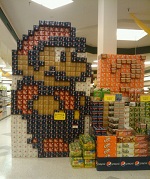In 2012, Target found itself at the center of a huge controversy (which you can read about here) because of a formula that their ‘Guest Marketing Analytic’ department had figured out; they called it “Customer Segmentation”.
They had figured out a formula involving the spending habits of pregnant women and determined that a series of 25 items, when bought together, and were out of the norm for that shopper, could indicate that the woman was pregnant. They could even calculate within a small time frame when she was expecting. This is apparently information they can easily track via customer loyalty cards and even when their customers use their debit and credit cards.
A teenage girl fit these spending habits and matched the formula that they had created, so Target began sending her coupons for diapers and maternity clothes…but… (wait for it)…. these coupons were intercepted by her father (queue shock and horror). The father went to his local Target, argued and fussed with the store manager (who had no knowledge of this formula that the higher ups had come up with) and when he confronted his daughter, discovered the surprise. She was indeed pregnant and just hadn’t announced it yet.
Is Target’s practice to gather this kind of information to track your spending habits and to scope out who you are legal? Well, so it seems. Is it creepy beyond belief? I’ll let you decide.
Moving on from Target
Without your knowledge, companies are compiling information on you from the instant you enter into the store; from something that has caught your eye, to how long you spend in the store, to what deals you are succumbing to. The end goal of all this? To make you stay longer in the store and to purchase more. Almost everything that that you see and hear in a store is carefully designed to appease you as a consumer and to tempt you to leave with more than you had planned. Ever wonder why they always place chocolates near the checkout lane and why you have to journey to the end of the store for milk? These are their sneaky ways of trapping you in the store; with the aim of turning you into an impulse shopper.
I must confess, I used to work as an assistant manager in a local grocery store, and I was a part of those bad guys that would secretly plan ways for you take more notes out of your wallet than you needed (but in a softer way). Granted, my experience is based on working in a grocery store, but some of the same techniques can be applied to any store. Clothing stores, for example, display their new and pricier stock at the very front in hopes of catching your eye and to draw you in. The sooner you can recognize the traps they set out for you, the faster you can avoid them. Let’s break it down for you.
Trap #1: The store layout
 Ever wondered why in the world would grocery stores put all the essentials (meat, bread, milk, the works) at the back of the supermarket and ridiculously separated from each other? Stores deliberately do it to make you stroll around more, hoping you’ll see the “amazing sales” that you just can’t live without. The average shopper has the tendency of shuffling into a store with a set goal of just a few items, yet they strut out with more than they planned, and angering their bank balance more than they had originally wished.
Ever wondered why in the world would grocery stores put all the essentials (meat, bread, milk, the works) at the back of the supermarket and ridiculously separated from each other? Stores deliberately do it to make you stroll around more, hoping you’ll see the “amazing sales” that you just can’t live without. The average shopper has the tendency of shuffling into a store with a set goal of just a few items, yet they strut out with more than they planned, and angering their bank balance more than they had originally wished.
This is a surprising gimmick that works more often then you think. Here’s an example from the store I use to work in: the milk was located at the back of the store, but to get to it, they purposely placed clearance bins and some of the best sales around the path that most people took to get to the milk. The result? Sale items sold more and clearance bins emptied quicker. Everything is carefully situated and changed often just for this reason. Also, have you ever asked yourself why stores change the layout of shelves periodically? It’s another ploy; their goal is to keep you looking and searching around the store in hopes that you grab something else than what you came for.
Items are strategically located on a shelf to make you ante up. The higher priced items with the biggest profit margins are positioned closer to eye level to be more visible. Brands of certain products even pay, at times, to have their items placed at eye level so you will notice them first and shell out more. A little bit lower, at the eye level of children, you’ll find items that are visually appealing to them. Haven’t we all been there when we were kids? We’d see an item we simply couldn’t live without and we’d cry and beg until our parent’s caved in.
Trap #2: Taking advantage of your five senses.
 Think about the last time you went shopping and carefully think about your experience in the store; did you think that, overall, the store was visually appeasing? Did anything disturb you in a way or put you off from your shopping experience? Everything you see in a store is carefully displayed in such a way that it will appeal to all of your senses in expectation that you either consume more in that trip or return in the future. Here’s exactly how grocery stores assault your five senses on a subconscious level without you even realizing it. Careful, it’s spooky.
Think about the last time you went shopping and carefully think about your experience in the store; did you think that, overall, the store was visually appeasing? Did anything disturb you in a way or put you off from your shopping experience? Everything you see in a store is carefully displayed in such a way that it will appeal to all of your senses in expectation that you either consume more in that trip or return in the future. Here’s exactly how grocery stores assault your five senses on a subconscious level without you even realizing it. Careful, it’s spooky.
Sight
All the display signs, the way the counters are set up, the overall visual look of the store… All are factors that are carefully thought-out to appease your eyes. Signs are either in bright, noticeable colors or they are flashing obnoxiously to grab your attention. Most, if not all stores, take special care to make sure that their store is impeccably clean in an effort to draw in business (would you really shop in a dirty store? I wouldn’t).
A gimmick I used was to make sure the shelves in my department were always full or had the ‘appearance’ of being full. My department had the advantage of being the first thing you see as you walk in, so first impressions meant everything. Displays and shelves from top to bottom had to be super clean and had the impression that the shelves were full. If a store had empty shelves as soon as you stepped in, how much confidence would you give them in keeping the item you came in for stocked? If we didn’t grab you within the first few seconds, that extra profit would be gone.
Smell
When you stride into a grocery store, what is usually the first thing that you smell? Is it the fresh croissants coming from the in-store bakery? Is it the flowers that they conveniently blooming at the front of the store? Grocery stores are notorious at attacking your sense of smell; they figure that if you smell something good, you are going to be hungry for it, and hopefully buy it. Grocery stores have been using this sensory trick for a while; they’d pump the scent of fresh bread cooking from the bakery to the entrance of the store just to entice you. Another example from my old department: we use to make a spaghetti sauce in-store and when it came out of the oven, it would fill the place up with its amazing aromas (it smelt gorgeous and tasted even better, honestly) and clients would flock to us demanding where that delicious smell came from. That product would sale ridiculously well just for this reason.
This article here also talks about how it’s currently in the works to pump artificial smells through the ventilation system to encourage you to buy what the store wants you to. It wouldn’t be over-bearing; it would be subtle and would hit you on a subconscious level. With the aim of creating desire (example: The smell of fresh cut grass to make you think about purchasing a lawnmower).
Taste

We’ve all seen it and we’ve all succumbed to it; the freebies. Those tasty little spots with free samples of cookies or beer or some sausage cooked to perfection. Companies will shell out big bucks to get a demonstration of their product in-store, with the aim that you will, yet again, add something new and unexpected to your trolley or switch to their product. In some grocery stores – and I adamantly pushed this with my employees – if a client was debating which sliced meat or salad to buy, we would offer them a free sample of a product of our choice to try. The end result? Increased sales in that particular product.
Touch
Letmefeelgood.com made an interesting point; Consumers are more likely to purchase things that they can touch, play with, and familiarize themselves with. It’s not because stores are lacking space that they have rows and rows of computers, cell phones and Mp3 players set up for demonstration; it’s so you can mess with them so you are tempted to buy them. They figure that the fonder you grow of an item, the more likely you are to buy it.
Grocery stores do the exact opposite, in a sense. They purposely try to free your hands in an attempt to get you to shop more. It’s no coincidence that they make shopping carts extra huge. As they see it, if your hands are free, then they are ‘freer’ to wander to other items to pile up your over-sized grocery cart. Consumers have a bad tendency of taking a bigger cart than needed and then feel the need to fill it, when it isn’t necessary.
Hearing
Stores purposely play music to suit what they are trying to sell; clothing stores play more up-beat music whereas grocery stores tend to play mellower, relaxed music. They hope that by listening to something calmer, you will be more relaxed and take your time in the store… Again, to get you to dip into your money pocket.
Ever noticed that “clicking” sound the floor makes under each footstep? That’s a gimmick as well; most people will slow down when they hear their feet clanking, because they are afraid of ‘making too much noise’. When you slow down your speed, you have more time to browse items and to potentially grab a few more items that weren’t on your list. They also make sure to limit the amount of noise from machines and other equipment, anything that would displease you senses.
Trap #3: The feeling of saving (when you’re not)

You’ve no doubt seen the signs before; the huge advertisements for a huge, epic sale of an item you just can’t live without. Stores draw you in with flashy signs claiming that you can save a certain amount of money or percentage. But buyer be warned! Most of the time when there’s huge discounts advertised, the mark-up before the sale is so ridiculously high, that in reality, you aren’t saving much. Another example from my old department; those fabulous BBQ chickens that are quick, easy and make a fast supper were being sold for $9.99+tax. The actual price we were paying? $6.94 per chicken. We would have sales announcing there was a $1.00 or a $2.00 rebate on the chicken and people would buy them like crazy. In reality, you weren’t saving much even when the item was on special.
The same logic applies when it comes to per-packaged items. Most, if not all items have the price per unit listed on per-packaged items (example: How much one can of Pepsi is when it comes in a case of 12). You might think you are saving by buying it in bulk, but are you really? Take a closer look at the packaging and the actual size of the items inside of it.
Clearance bins and end-caps (the displays listed at the end of an aisle in a store) are also notorious for attempting to draw you in with sales. Double check the next time you go fishing in a clearance bin or a sales rack; what’s the original price of the item? The money you could potentially save might not be that big in the first place. People are quick to say how much they saved on a certain item, but more easily forget about how much they actually spent.
Here’s another tactic used. The fabulous “Buy one, get one free” deals. Sure, it’s a good idea if your original intent was to buy the item, because you get a free item in the process (and I’m never going to say no to something that is free). But what if you weren’t planning on spending the extra money? Yes, you get a free item out of the process, but you end up shelling out more than you needed and could potentially waste an item you didn’t need in the first place.
Trap #4: Appealing to your desires
 In this day and age where plastic cards are the common way of purchasing things, it’s very easy for companies to track your spending habits. That’s how Target managed to determine the teenage girl was pregnant before she even found out herself; they traced her buying habits via the purchases she was making by using her Target credit/debit card. They were able to track everything about her; her age, gender, location, preferences when it came to items… the whole shebang. They had begun to send her maternity coupons because she fit the formula and they thought she might be interested in them.
In this day and age where plastic cards are the common way of purchasing things, it’s very easy for companies to track your spending habits. That’s how Target managed to determine the teenage girl was pregnant before she even found out herself; they traced her buying habits via the purchases she was making by using her Target credit/debit card. They were able to track everything about her; her age, gender, location, preferences when it came to items… the whole shebang. They had begun to send her maternity coupons because she fit the formula and they thought she might be interested in them.
Since that scandal, Target has changed the way they send out coupons. Let’s say they were trying to push maternity coupons on you, they would randomly throw in a bunch of items they know you’ll never use to make it less conspicuous, like coupons for a lawnmower or for men’s wear. Most women will think that these are generic coupons that were sent to everyone on her block and not think twice that these were specifically catered to her. It’s the same principle when it comes to a clothing store; if they can see that you have a tendency to buy more jeans then socks at their store, they aren’t about to send you coupons for socks. Companies want to entice you to visit their store and to buy as much as possible. Let’s use the maternity coupons, for example: When you visit Target with these coupons in hand, you might just notice that there’s a sale for Orange Juice going on and you remember that you need that at home, so you pick that up at the same time. Once again, you’ll walk out with more than you had bargained for.
Let’s go back to the department I used to work in; as I used to take care of the ordering, I noticed that anything spicy would sell more than the mild stuff. So we proceeded to order products that were either spicy or hot to boost sales. The result? Increased sales in everything we had to offer because clients were looking for more options and picked up extra things in the process.
Once you can recognize these traps, tricks and the subtler, the easier it is to avoid their desires to separate you from your money. Do you have any other tricks or tips on how to avoid their tactics? Let me know in the comment box below!
